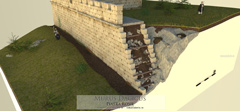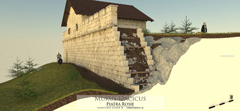Murus Dacicus
Incet-incet, reconstituiri 3D ale vechilor asezari de pe teritoriul actualei Romanii, fostul teritoriu al Geto-Daciei, vor fi publicate pe site-ul www.romaniadevis.ro
Murus dacicus reprezintă un stil caracteristic dacilor, pentru construirea fortificaţiilor. Este o îmbinare între stilul tradiţional dac, cu elemente moderne pentru acele vremuri, din arhitectura romană si grecească.
Zidurile de apărare erau groase de trei metri, ceea ce pentru acea epocă era o performanţă deosebită, dacă ţinem seama de faptul că erau înalte de zece metri.
Murus dacicus este un stil arhitectonic propriu dacic, nemaifiind întâlnit în altă parte a lumii.
Murus Dacicus (Latin for Dacian Wall) is a construction method for defence walls and fortifications developed in ancient Dacia sometime before the Roman conquest. It is a mix between traditional construction methods particular to Dacian builders and methods imported from Greek and Roman architecture and masonry, and - although somewhat similar construction techniques were used before, during and long after the period - it has peculiarities that make it unique.
Murus Dacicus consisted of two outer walls made out of stone blocks carved in the shape of a rectangular parallelepiped; apparently no mortar was used, thus making them examples of ashlar masonry - but typically done with regular sized, bigger-than-average blocks, due to technological requirements. After each layer of the outer walls was completed, the gap between them would be filled with gravel and rocks cemented together with clay and compacted (cf. also rammed earth technique). The structure was strengthened and consolidated at the level of each layer by horizontal, singed/scorched wood tie beams connected to the outer walls by means of a dovetail joint at the upper surface of the stone block (hence the need for big stone blocks of the same size). Due to its higher flexibility, this structure had a distinct advantage over the 'classical', solid dry stone wall (as seen, e. g., in the cyclopean and ashlar walls in Mycenae): a higher capability of shock absorption and dissipation of kinetic energy from an incoming projectile thrown by a siege weapon. However, archaeological and historical evidence suggests that the wall might have been topped by a wooden palisade instead of stone battlements, which had the obvious disadvantage of being vulnerable to fire.
A properly built Dacian Wall would be both labor intensive and time consuming. A typical wall for the late period, hastily built in the short years between the two Dacian Wars (when Dacia had to rebuild, repair, enlarge or reinforce the defences of many of its key fortesses), would be about 3-4 meters thick and 10 m tall, an outstanding achievement in the given conditions.
The Dacian Fortresses of the Orăştie Mountains, UNESCO World heritage sites are examples of citadels built using this method. Also the Dacian walls are depicted on the Trajan's column in Rome.
http://ro.wikipedia.org/wiki/Murus_dacicus
http://en.wikipedia.org/wiki/Murus_dacicus
// UPDATE: citeste articolul "Murus dacicus" v2
Reconstituirea virtuala 3D a "Murus dacicus" de la Piatra Rosie (click pe poza pentru marire).
- Adăugat în: Reconstituiri 3D, Mestesuguri
- Vizualizări: 17827







